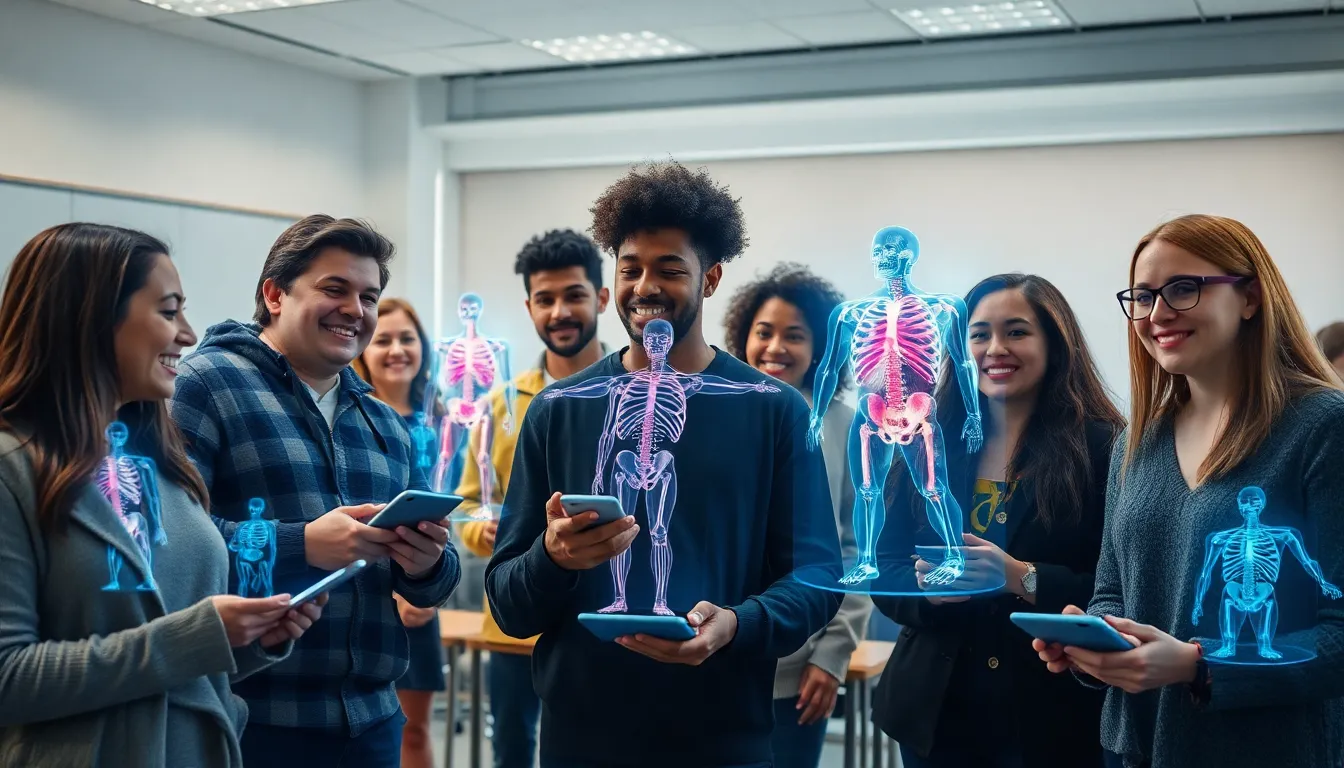Imagine walking down the street and spotting a dinosaur casually sipping coffee at your local café. Sounds wild, right? Welcome to the world of augmented reality (AR), where the line between the digital and physical blurs in the most delightful ways. This tech marvel overlays digital information onto the real world, transforming everyday experiences into something straight out of a sci-fi movie.
AR isn’t just for gamers or tech enthusiasts; it’s revolutionizing industries from education to healthcare. Picture students exploring ancient civilizations through interactive lessons or doctors using AR to visualize complex anatomy during surgeries. With its potential to enhance our reality, AR is more than just a nifty gadget—it’s a game changer. So buckle up as we dive into the fascinating realm of augmented reality and uncover how it’s reshaping the world around us.
Table of Contents
ToggleWhat Is Augmented Reality?
Augmented reality (AR) integrates digital content within the physical world, enhancing real-life environments with computer-generated elements. With AR, users can experience interactive visuals and sounds that overlay their actual surroundings, making it possible to engage with both simultaneously.
Applications of AR span various sectors. In education, AR brings textbooks to life, allowing students to visualize complex concepts in three dimensions. It offers immersive learning experiences, thereby boosting comprehension. In healthcare, AR aids surgeons by overlaying critical information during procedures, improving accuracy and outcomes.
Retail benefits from AR as well. Customers can try on clothes virtually or place furniture in their homes using their smartphones, streamlining the shopping process. It transforms how consumers interact with products, significantly increasing engagement and satisfaction.
Moreover, AR plays a role in tourism. Travelers utilize AR apps to access additional information about landmarks in real time. Tourists benefit from enhanced experiences that provide context and historical background, enriching their understanding of the locations they visit.
Despite its many advantages, AR technology faces challenges. Device compatibility and accessibility remain concerns, limiting widespread adoption. Addressing these issues will improve user experience and broaden AR’s application scope.
AR represents a significant progression in technology. By merging the physical with the digital, it continues to impact various industries, enhancing everyday experiences and reshaping interactions with the world.
Key Features of Augmented Reality

Augmented reality (AR) offers unique features that enhance various experiences. These capabilities significantly transform how individuals interact with digital content.
Enhanced User Experience
Enhanced user experience is a hallmark of AR technology. Users engage with their environments in new ways, integrating digital elements seamlessly. For instance, AR enables interactive learning through immersive educational tools. Students visualize anatomy by viewing 3D models overlapping real-world settings. Retail applications allow customers to virtually try on products, enhancing the shopping experience. Such experiences reduce uncertainty and increase confidence in purchasing decisions. Additionally, AR fosters creativity, empowering users to design through direct interaction. Overall, enhanced user experience illustrates the transformative potential that AR holds across various sectors.
Real-Time Interaction
Real-time interaction is another critical feature of augmented reality. This capability allows users to interact with digital objects as if they exist in their physical surroundings. Instant feedback enriches engagement levels, making experiences more dynamic. For example, during navigation, users receive live updates on traffic conditions or directions overlayed on their environment. In gaming, players can battle virtual foes blended seamlessly with real landscapes. Additionally, AR technologies support collaborative tasks in professional settings, facilitating remote interactions between teams. Enhanced productivity stems from these real-time abilities, showcasing AR’s versatility and growing relevance in today’s tech landscape.
Applications of Augmented Reality
Augmented reality (AR) finds use in diverse fields, showcasing its versatility and transformative impact.
In Education
AR revolutionizes education by integrating visual and interactive elements into learning materials. Students experience enhanced understanding as textbooks become immersive environments. Interactive simulations allow learners to explore complex scientific concepts, like anatomy in three dimensions. Teachers use AR tools to create engaging lessons, driving student participation and improving retention rates. Instances of AR applications in classrooms include virtual field trips, which expose students to historical sites without leaving the school. Research indicates that AR can significantly improve learning outcomes, making it a valuable resource for educators.
In Healthcare
In healthcare, AR plays a crucial role in improving surgical precision and patient outcomes. Surgeons leverage AR to visualize vital information during procedures, which enhances decision-making in real-time. AR assists in pre-operative planning by overlaying critical data on the patient’s anatomy through advanced imaging. Medical training also benefits from AR; students practice procedures in simulated, lifelike environments that enhance skills without patient risk. Studies show a reduction in surgery-related errors when AR technology is utilized, showcasing its importance in enhancing safety and efficiency in medical practices.
In Entertainment
Entertainment experiences undergo transformation through the integration of AR technology. Games like Pokémon GO illustrate how AR captures players’ attention by blending digital elements with the real world. Users interact with fictional characters appearing in real locations, creating engaging gameplay that promotes physical activity. Beyond gaming, AR enhances live events and concerts, offering unique interactive experiences for the audience. Certain apps enable users to enjoy additional content, such as behind-the-scenes footage or exclusive artist meet-and-greets. Data suggests that the AR market in entertainment is projected to grow significantly, indicating widespread acceptance and interest in these innovative experiences.
Advantages and Disadvantages
Augmented reality offers numerous benefits alongside certain limitations. Understanding these aspects is essential for leveraging AR technology effectively.
Benefits of Augmented Reality
Enhancing user interaction represents a key advantage of AR. Users can engage directly with digital information, creating immersive learning experiences. In education, students visualize complex subjects through interactive 3D models, making concepts easier to grasp. Retail environments also benefit significantly. Customers enjoy trying on clothes virtually or placing furniture in their homes before making purchases. AR also boosts productivity in industries like healthcare. Surgeons access vital information during procedures, leading to improved accuracy and outcomes. Overall, these applications demonstrate how AR enriches user experiences across multiple sectors.
Limitations and Challenges
Device compatibility remains a significant challenge for AR adoption. Not all smartphones or tablets support AR features, limiting access for some users. Additionally, high costs are associated with AR development and implementation, which can deter smaller businesses from investing. Privacy concerns also arise, as AR applications may gather sensitive user data, raising ethical questions. The immersion level in AR experiences can depend heavily on environmental conditions, leading to varying user experiences. Addressing these limitations is crucial for maximizing AR’s potential in transforming industries and everyday interactions.
The Future of Augmented Reality
Augmented reality (AR) is poised to revolutionize several industries moving forward. Industries like education, healthcare, and retail will likely see further integration of AR technologies. In education, AR can transform learning experiences by visualizing complex subjects in engaging ways. Students will immerse themselves in interactive materials, enhancing comprehension and retention.
Healthcare’s landscape will also shift significantly as AR technologies advance. Surgeons will rely on AR overlays for critical data during procedures, which can improve precision and patient outcomes. In addition, medical training programs can utilize AR simulations to prepare future healthcare professionals in simulated environments.
Retail will evolve with more interactive shopping experiences. Shoppers may soon select virtual fitting rooms to try on clothes or visualize how furniture complements their home settings. Such advancements will lead to informed purchasing decisions.
Furthermore, tourism can benefit immensely from AR applications. Travelers may use AR to receive immediate information about landmarks and local attractions, enhancing their exploration of new destinations.
Despite its promising future, some challenges persist, including device compatibility and accessibility. Developers must address high costs and privacy concerns to promote broad adoption. As these barriers are overcome, AR’s potential to enrich daily life and alter industry practices becomes increasingly clear.
Innovative applications are already emerging, suggesting a future where AR significantly enhances interactive experiences. As the technology matures, its integration into daily activities will likely become more seamless, driving engagement and productivity across numerous fields. The future of augmented reality holds immense potential to reshape interactions with the physical world.
Augmented reality is more than just a technological trend; it’s a powerful tool reshaping how people interact with the world around them. By merging digital content with physical environments, AR enhances learning, healthcare, retail, and entertainment. Its ability to provide real-time interaction and immersive experiences makes it invaluable across various sectors.
As AR continues to evolve, its potential to transform everyday experiences and industry practices only grows. While challenges like device compatibility and privacy concerns remain, addressing these issues will unlock even greater possibilities. The future of augmented reality promises to enrich lives and create engaging interactions that redefine how we perceive our surroundings.






